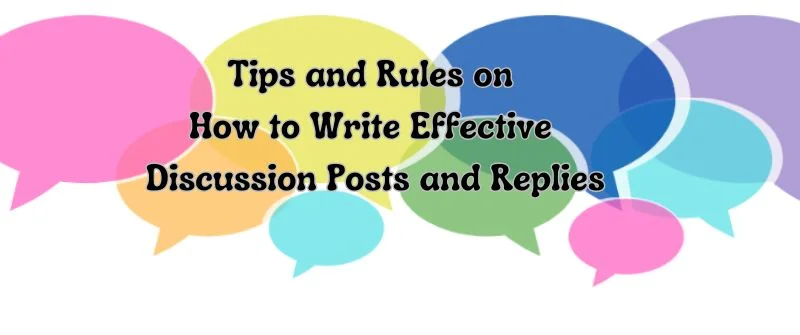How to Write Effective Discussion Posts and Replies: Tips and Rules

Coming up with good discussion posts and replies is imperative when engaging in meaningful academic or online conversations.
This article will explain in detail what discussion posts and replies are and how to best write them so that they can be thoughtful and impactful.
What are Discussion Posts?
Discussion posts can be regarded as written contributions made on discussion boards, online platforms, or any other platform created to facilitate interactive communication.

The posts are normally part of a much larger conversation allowing participants to share their ideas, thoughts, information, and opinions on particular topics.
Types of Discussion Posts
1. Informative Posts
One of the most common forms of discussion posts is informative posts. Such posts convey knowledge, provide factual information, or share data concerning a particular topic.
Informative posts are usually written clearly and concisely in such a way that they are supported by evidence and references.
The main focus of these posts is to present factual information instead of expressing subjective or personal information.
2. Analytical Posts
Analytical posts are also common in discussion posts. They are meant to analyze and evaluate concepts, situations, or topics by breaking them down into their constituents, identifying the patterns, and exploring their cause-and-effect associations.
Characteristically, analytical posts are in-depth with a lot of critical thinking involved. An individual writing such a post should apply reasoning and logic to support their conclusions.
The posts may also involve drawing comparisons from different perspectives.
3. Reflective Posts
These are very common forms of discussion posts. This is because their purpose is to share personal thoughts, feelings, or experiences related to the topic.
They allow an individual to reflect and share how the subject matter affects them at a personal level and their understanding.

As such, reflective posts are subjective because they share what an individual feels about the topic.
They use first-person language and may include perceptions acquired from connections to the course content or personal experiences.
4. Interactive Posts
Interactive posts are meant to encourage collaboration and engagement within the discussion. They enhance conversation by seeking input, posing questions, or responding to other participants’ posts.
Interactive posts are characterized by open-ended prompts or questions that simulate conversation. Replies to others are very common hence creating a participatory and dynamic discussion.
Also Read: Elements of a Good Paragraph: The Kasen Paragraphing Model
Components of a Well-Crafted Discussion Post
1. Craft Compelling Titles and Openers
A well-crafted discussion post should have a compelling title and openers. The title should be interesting and capable of capturing the attention of the readers immediately.
The same case should be applied to openers where the first sentence or paragraphs of the post are catchy. They should make the reader want to continue reading the post.
2. Provide Context and Background Information
A well-crafted discussion post should also give context and background information on the topic. It should let the readers immediately know what they are going to read or be informed in the post.
The context and background information should be provided at the beginning of the post to help the readers know what to expect.
3. Formulate Clear and Concise Arguments
As noted, discussion posts are meant to foster conversation about a particular topic. As such, the arguments presented should be clear and concise to facilitate understanding.
The participants should completely understand the arguments presented in a post before they can respond to them.
4. Supporting Arguments with Evidence and Examples
A compelling discussion post should have evidence to support the arguments. The aim is to demonstrate knowledge on a particular subject matter, hence the reason it is imperative to give evidence.
Examples should also be provided to help the readers better understand the content and context of the post. Examples illustrate what the writer intends their readers to understand.
5. Encourage Engagement and Interaction
Discussion posts should also encourage engagement and interaction. This is because posts are meant to foster a conversation among participants.
To ensure this happens, the posts may pose questions, provoke thought, disapprove of some concepts, agree, disagree, and so on. This enhances engagement and interaction.
6. End with a Thought-Provoking Conclusion
To ensure that the discussion post encourages engagement and is worth replies, it should end with a thought-provoking conclusion.
A thought-provoking conclusion ensures that the readers know that you wish for the conversation to continue and that you anticipate their feedback.
7. Establish Clear Objectives for Your Discussion
An effective discussion post should also have clear objectives. It should instantly demonstrate the reason behind its creation.

Readers should quickly understand the purpose of the post as soon as they read the post. It should be immediately evident.
Also Read: Meet the Best Argumentative Essay Writers and How they do it
How to write interactive Discussion Replies
Understand the Role of Replies in Discussions
You should first understand the purpose of replies to discussion posts. You should know that the reply is meant to provoke thought and further conversation.
Replies should not sound condescending or dismissive of another person’s ideas. They should enhance the participants’ understanding of the subject matter.
Active Listening in Replies
To give an effective reply to a discussion post, you should practice active listening so that you can completely understand what the other person is talking about.
Acknowledge and Build Upon Others’ Points
When replying, make sure that you acknowledge the contributor of the post. Show them respect by demonstrating that you appreciate their perspectives and knowledge.
Once you are done with that, build upon their points instead of deviating to other issues or topics. The aim is to enhance everyone’s understanding of the subject matter.
Combine Constructive Criticism vs. Negative Feedback in Replies
Replies should contain both constructive criticism and negative feedback to enhance the conversation.
This provokes thought and ensures that other parties will join in the conversation to support or dismiss the arguments.
Also Read: Cause and Effect Essay ideas – 21 Examples of Cause and Effect Topics
Engaging Writing Techniques for Discussion Posts and Replies
Using Engaging Language and Tone

Always use engaging language and tone when writing discussion posts and replies. This is because discussion posts are meant to promote conversation about a specific subject matter.
Incorporating Visuals and Multimedia
Visuals and multimedia are a good way to make your discussion posts and replies engaging. They help illustrate and elaborate arguments and concepts better.
Asking Thoughtful Questions to Prompt Responses
Thoughtful questions are essential in prompting responses. Ask meaningful questions relating to the post to receive a response.
Using Personal Experiences or Anecdotes to Connect
To enhance your arguments, use personal experiences or anecdotes to connect with your target readers. It will help the readers perceive the arguments through your point of view.
Also Read: Is using a Paraphrasing Tool Cheating? Paraphrasing Dos & Don’ts
How to Structure Your Discussion Posts and Replies
1. Organizing your Thoughts: Outlining and Drafting
When crafting discussion posts and replies, plan by organizing your thoughts. Even though they are usually brief, outline and draft your discussion posts and replies before submitting them.
2. Use Paragraphs and Bullet Points
You can use a combination of paragraphs and bullet points in your discussion posts and replies depending on the context and contents.
The paragraphs should contain individual and complete points while bullet points should summarize or highlight key discussions in brief.
3. Emphasize Key Points with good Formatting
To ensure that key points are visible to the reader, you can format them differently. You may emphasize them using bold or italic fonts. Also, you can also capitalize or underline them.
You can also separate the key points from the paragraph to emphasize them.
How to Fostering a Collaborative Tone in Discussions
Encouraging Diversity of Thought and Perspectives
Effective collaboration is achieved by encouraging diversity of thought and perspective. Acknowledge that others have different perspectives and have the right to contribute as well.
Practicing Civility and Respect in Discussions
Posts and replies should be respectful despite differences in perspectives. Discussions should be courteous.
Building on Others’ Contributions
Discussion posts are meant to enhance the understanding of a particular subject matter. As such, people should build upon others’ contributions to achieve the desired level of understanding.
Being Proactive: Initiating Discussions
Do not wait for others to post replies or comments. Be proactive by initiating discussions. This will help you understand the subject matter more.
Prompt Response Timing and Frequency
When engaged in discussion posts, provide prompt responses whenever required. Do not delay on responses.
Encouraging Participation and Inclusivity
Effective discussion posts and replies encourage participation and inclusivity. They are open-ended or thought-provoking to ensure replies. Every participant should be included.
Also Read: How to Write a Peer Review Essay: Guidelines for Students
Tools and Platforms for Discussion Posts and Replies
Choosing the Right Platform for Your Discussions

Always select a platform that has the desired users. It should have satisfactory traffic. For example, if the discussion is academic, use academic platforms with students.
Leveraging Features for Improved Interaction
The features available in the platform can be leveraged to improve interaction. Those can be quick reply options, file attachments for pasting photos or other documents, group rely, and so on.
Likes, Replies, Threads, etc.
The platforms also offer features that allow users to like or reply to a post. Such features should be leveraged to enhance interaction.
Threads indicate the entire conversation. This can help users follow the entire conversation to better understand the subject matter.
Also Read: Can you use References in the Introduction paragraph of an Essay
Conclusion
To sum it up, discussion posts and replies allow the participants to exchange ideas and contribute to other members’ perspectives.
They should be written in such a way that they provoke deeper and meaningful discussion concerning the subject matter. They should be civil and respectful.

Josh Jasen or JJ as we fondly call him, is a senior academic editor at Grade Bees in charge of the writing department. When not managing complex essays and academic writing tasks, Josh is busy advising students on how to pass assignments. In his spare time, he loves playing football or walking with his dog around the park.




